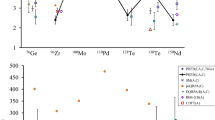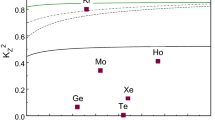Abstract
In this work, we present a theoretical study of the electron spectral shapes for the second-forbidden nonunique \(\beta ^-\)-decay transitions \(^{59}\text {Fe}(3/2^-)\rightarrow \,^{59}\text {Co}(7/2^-)\) and \(^{60}\text {Fe}(0^+)\rightarrow \,^{60}\text {Co}(2^+)\) in the framework of the nuclear shell model. We have computed the involved wave functions by carrying out a complete \(0\hbar \omega \) calculation in the full fp model space using the KB3G and GXPF1A effective interactions. When compared with the available data, these interactions predict the low-energy spectra and electromagnetic properties of the involved nuclei quite successfully. This success paves the way for the computations of the \(\beta \)-decay properties, and comparison with the available data. We have computed the electron spectral shapes of the mentioned decay transitions as functions of the value of the weak axial coupling \(g_{\mathrm{A}}\). By comparing these computed shapes with the measured spectral shapes allows then to extract the effective value of \(g_{\mathrm{A}}\) for these decay transitions. This procedure, coined the spectrum-shape method (SSM) in several earlier studies, complements the method of determining the value of \(g_{\mathrm{A}}\) by reproducing the (partial) half-lives of decay transitions. Here we have enhanced the original SSM by constraining the value of the relativistic vector matrix element, \(^V{\mathcal {M}}^{(0)}_{KK-11}\), using the conserved vector-current hypothesis (CVC) as a starting point. We hope that this finding would be a strong incentive to measure the spectral shapes in the future.










Similar content being viewed by others
Data Availability Statement
This manuscript has no associated data or the data will not be deposited. [Authors’ comment: This is the theoretical work all results we have already reported.]
References
K. Zuber, Neutrino Physics (Institue of Physics Publishing Ltd., London, 2004)
E.D. Commins, Weak Interactions (McGraw-Hill, New York, 2007)
J. Suhonen, O. Civitarese, Weak-interaction and nuclear-structure aspects of nuclear double beta decay. Phys. Rep. 300, 123 (1998)
J. Maalampi, J. Suhonen, Neutrinoless double \(\beta ^+\)/EC decays. Adv. High Energy Phys. 2013, 505874 (2013)
J. Suhonen, Value of the axial-vector coupling strength in \(\beta \) and \(\beta \beta \) decays: a review. Front. Phys. 5, 55 (2017)
H. Ejiri, J. Suhonen, K. Zuber, Neutrino-nuclear responses for astro-neutrinos, single beta decays and double beta decays. Phys. Rep. 797, 1 (2019)
H. Ejiri, N. Soukouti, J. Suhonen, Spin-dipole nuclear matrix elements for double beta decays and astro-neutrinos. Phys. Lett. B 729, 27 (2014)
H. Ejiri, J. Suhonen, GT neutrino-nuclear responses for double beta decays and astro neutrinos. J. Phys. G: Nucl. Part. Phys. 42, 055201 (2015)
J. Suhonen, O. Civitarese, Probing the quenching of \(g_A\) by single and double beta decays. Phys. Lett. B 725, 153 (2013)
J. Suhonen, O. Civitarese, Single and double beta decays in the \(A=100\), \(A=116\) and \(A=128\) triplets of isobars. Nucl. Phys. A 924, 1 (2014)
A. Faessler, G.L. Fogli, E. Lisi, V. Rodin, A.M. Rotunno, F. \(\check{\text{S}}\)imkovic, Overconstrained estimates of neutrinoless double beta decay within the QRPA. J. Phys. G: Nucl. Part. Phys. 35, 075104 (2008)
D.S. Delion, J. Suhonen, Effective axial-vector strength and \(\beta \)-decay systematics. Eur. Phys. Lett. 107, 52001 (2014)
P. Pirinen, J. Suhonen, Systematic approach to \(\beta \) and \(2\nu \beta \beta \) decays of mass \(A=100-136\) nuclei. Phys. Rev. C 91, 054309 (2015)
F.F. Deppisch, J. Suhonen, Statistical analysis of \(\beta \) decays and the effective value of \({g}_{A}\) in the proton-neutron quasiparticle random-phase approximation framework. Phys. Rev. C 94, 055501 (2016)
B.H. Wildenthal, M.S. Curtin, B.A. Brown, Predicted features of the beta decay of neutron-rich \(\rm sd\)-shell nuclei. Phys. Rev. C 28, 1343 (1983)
G. Martínez-Pinedo, A. Poves, E. Caurier, A.P. Zuker, Effective \({g}_{A}\) in the \(\rm pf\) shell. Phys. Rev. C 53, R2602 (1996)
E. Caurier, F. Nowacki, A. Poves, Shell Model description of the \(\beta \beta \) decay \(^{136}\)Xe. Phys. Lett. B 711, 62 (2012)
V. Kumar, P.C. Srivastava, H. Li, Nuclear \(\beta ^-\)-decay half-lives for \(fp\) and \(fpg\) shell nuclei. J. Phys. G: Nucl. Part. Phys. 43, 105104 (2016)
V. Kumar, P.C. Srivastava, Shell model description of Gamow-Teller strengths in \(pf\)-shell nuclei. Eur. Phys. J. A 52, 181 (2016)
A. Saxena, P.C. Srivastava, T. Suzuki, Ab initio calculations of Gamow-Teller strengths in the \(sd\) shell. Phys. Rev. C 97, 024310 (2018)
A. Kumar, P.C. Srivastava , T. Suzuki, Shell model results for nuclear \(\beta ^-\)-decay properties of sd-shell nuclei. Prog. Theo. Expt. Phys. 2020, 033D01 (2020)
J. Kostensalo, J. Suhonen, Consistent large-scale shell-model analysis of the two-neutrino \(\beta \beta \) and single \(\beta \) branchings in \(^{48}\)Ca and \(^{96}\)Zr. Phys. Lett. B 802, 135192 (2020)
J. Barea, J. Kotila, F. Iachello, \(0\nu \beta \beta \) and \(2\nu \beta \beta \) nuclear matrix elements in the interacting boson model with isospin restoration. Phys. Rev. C 91, 034304 (2015)
J. Barea, J. Kotila, F. Iachello, Nuclear matrix elements for double-\(\beta \) decay. Phys. Rev. C 87, 014315 (2015)
N. Yoshida, F. Iachello, Two-neutrino double-\(\beta \) decay in the interacting boson-fermion model. Prog. Theo. Expt. Phys. 2013, 043D01 (2013)
J. Suhonen, J. Kostensalo, Double \(\beta \) decay and axial strength. Front. Phys. 7, 29 (2019)
E.K. Warburton, First-forbidden \(\beta \) decay in the lead region and mesonic enhancement of the weak axial curren. Phys. Rev. C 44, 233 (1991)
J. Kostensalo, J. Suhonen, Mesonic enhancement of the weak axial charge and its effect on the half-lives and spectral shapes of first-forbidden \(J^+\leftrightarrow J^-\) decay. Phys. Lett. B 781, 480 (2018)
S. Pastore, A. Baroni, J. Carlson, S. Gandolfi, S.C. Pieper, R. Schiavilla, R.B. Wiringa, Quantum Monte Carlo calculations of weak transitions in \(A=6-10\) nuclei. Phys. Rev. C 97, 022501(R) (2018)
G.B. King, L. Andreoli, S. Pastore, M. Piarulli, R. Schiavilla, R.B. Wiringa, J. Carlson, S. Gandolfi, Chiral effective field theory calculations of weak transitions in light nuclei. Phys. Rev. C 102, 025501 (2020)
P. Gysbers, G. Hagen, J.D. Holt, G.R. Jansen, T.D. Morris, P. Navrátil, T. Papenbrock, S. Quaglioni, A. Schwenk, S.R. Stroberg, K.A. Wendt, Discrepancy between experimental and theoretical \(\beta \)-decay rates resolved from first principles. Nat. Phys. 15, 428 (2019)
J. Engel, J. Menéndez, Status and future of nuclear matrix elements for neutrinoless double-beta decay: a review. Rep. Prog. Phys. 80, 046301 (2017)
M. Haaranen, P.C. Srivastava, J. Suhonen, Forbidden nonunique \(\beta \) decays and effective values of weak coupling constants. Phys. Rev. C 93, 034308 (2016)
M. Haaranen, J. Kotila, J. Suhonen, Spectrum-shape method and the next -to-leading-order terms of the \(\beta \)-decay shape factor. Phys. Rev. C 95, 024327 (2017)
P. Belli, R. Bernabei, N. Bukilic, F. Cappella, R. Cerulli, C.J. Dai, F.A. Danevich, J.R. de Laeter, A. Incicchitti, V.V. Kobychev, S.S. Nagorny, S. Nisi, F. Nozzoli, D.V. Poda, D. Prosperi, V.I. Tretyak, S.S. Yurchenko, Investigation of \(\beta \) decay of \(^{113}\rm Cd\). Phys. Rev. C 76, 064603 (2007)
J. Kostensalo, M. Haaranen, J. Suhonen, Electron spectra in forbidden \(\beta \) decays and the quenching of the weak axial-vector coupling constant \(\text{ g}_A\). Phys. Rev. C 95, 044313 (2017)
J. Kostensalo, J. Suhonen, \(\text{ g}_A\)-driven shapes of electron spectra of forbidden \(\beta \) decays in the nuclear shell model. Phys. Rev. C 96, 024317 (2017)
A. Kumar, P.C. Srivastava, J. Kostensalo, J. Suhonen, Second-forbidden nonunique \({\beta }^{-}\) decays of \(^{24} \text{ Na }\) and \(^{36} \text{ Cl }\) assessed by the nuclear shell model. Phys. Rev. C. 101, 064304 (2020)
O.S. Kirsebom et al., Measurement of the \(2^+\rightarrow {0^+}\) ground-state transition in the \(\beta \) decay of \(^{20}\)F. Phys. Rev. C 100, 065805 (2019)
O.S. Kirsebom et al., Discovery of an exceptionally strong \(\beta \)-decay transition of \(^{20}\)F and implications for the fate of intermediate-mass stars. Phys. Rev. Lett. 123, 262701 (2019)
M. Honma, T. Otsuka, B.A. Brown, T. Mizusaki, New effective interaction for \(pf\)-shell nuclei and its implications for the stability of the \(N=Z=28 \) closed core. Phys. Rev. C 69, 034335 (2004)
M. Honma, T. Otsuka, B.A. Brown, T. Mizusaki, Shell-model description of neutron-rich \(pf\)-shell nuclei with a new effective interaction GXPF1. Eur. Phys. J. A 25, 499 (2005)
A. Poves, J. S\(\acute{\text{ a }}\)nchez-Solano, E. Caurier, F. Nowacki, Shell model study of the isobaric chains A = 50, A = 51 and A = 52. Nucl. Phys. A 694 157 (2001)
H. Behrens , W. B\(\ddot{\text{ u }}\)hring, Electron Radial Wave Functions and Nuclear Beta-Decay (Clarendon Press, Hoboken, 1982)
H.F. Schopper, Weak Interaction and Nuclear Beta Decay (North-Holland, Amsterdam, 1966)
M. T. Mustonen, M. Aunola, J. Suhonen, Theoretical description of the fourth-forbidden non-unique \(\beta \) decays of \(^{113}\)Cd and \(^{115}\)In. Phys. Rev. C 73, 054301 (2006) [Erratum Phys. Rev. C 76 019901 (2007)]
J. Suhonen, From Nucleons to Nucleus: Concept of Microscopic Nuclear Theory (Springer, Berlin, 2007)
C. Patrignani and Particle Data Group, Review of Particle Physics. Chin. Phys. C 40, 100001 (2016)
B.A. Brown, W.D.M. Rae, The shell-model code NuShellX@MSU. Nucl. Data Sheets 120, 115 (2014)
NNDC, https://www.nndc.bnl.gov/ensdf/ (2020)
L. Bodenstein-Dresler et al., (COBRA Collaboration), Quenching of \(g_{{\rm A}}\) deduced from the \(\beta \)-spectrum shape of \(^{113}\)Cd measured with the COBRA experiment. Phys. Lett. B 800, 135092 (2020)
Acknowledgements
A. K. would like to thank the Ministry of Human Resource Development (MHRD), Government of India, for the financial support for his Ph.D. thesis work. P.C.S. acknowledges a research grant from SERB (India), CRG/2019/000556. J. S. has been partially supported by the academy of Finland under the academy project no. 318043.
Author information
Authors and Affiliations
Corresponding author
Additional information
Communicated by Kamila Sieja.
Rights and permissions
About this article
Cite this article
Kumar, A., Srivastava, P.C. & Suhonen, J. Second-forbidden nonunique \(\beta ^-\) decays of \(^{59,60}\)Fe:possible candidates for \(g_{\mathrm{A}}\) sensitive electron spectral-shape measurements. Eur. Phys. J. A 57, 225 (2021). https://doi.org/10.1140/epja/s10050-021-00540-6
Received:
Accepted:
Published:
DOI: https://doi.org/10.1140/epja/s10050-021-00540-6




